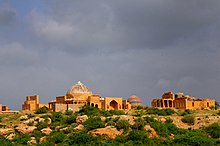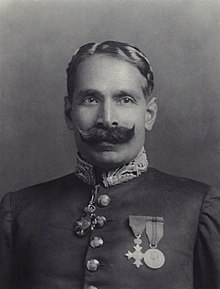
History of Rajput families in Pakistan
Muslim Rajputs or Musalman Rajpoots are the descendants of Rajputs in the northern regions of the Indian subcontinent who generally are followers of Islam.[1] Reportedly, they converted from Hinduism to Islam from the medieval period onwards, creating various dynasties and states while retaining Hindu surnames such as Chauhan.[2][3][4] Today, Muslim Rajputs can be found mostly in present-day Northern India and Pakistan.[5] They are further divided into different clans.[6]
History[edit]
The term Rajput is traditionally applied to the original Suryavanshi, Chandravanshi and Agnivanshi clans, who claimed to be Kshatriya in the Hindu varna system.[citation needed]
Conversion to Islam and ethos[edit]
Upon their conversion from Hinduism to Islam, many Muslim Rajputs maintained many of their Hindu customs, and hence retained their Cultural Hindu identity.[2] Muslim Rajputs also often retained common social practices, such as purdah (seclusion of women), with Hindu Rajputs.[5]
Despite the difference in religious faith, where the question has arisen of common Rajput honour, there have been instances where both Muslim and Hindu Rajputs have united together against threats from external ethnic groups.[7][weasel words]
There are recorded instances of recent conversions of Rajputs to Islam in Western Uttar Pradesh, Khurja tahsil of Bulandshahr.[8]
Muslim Rajput dynasties[edit]
Kharagpur Raj[edit]
Main article: Kharagpur Raj
The Kharagpur Raj was a Muslim Kindwar Rajput chieftaincy in modern-day Munger district of Bihar.[9][10] Raja Sangram Singh led a rebellion against the Mughal authorities and was subsequently defeated and executed. His son, Toral Mal, was made to convert to Islam and renamed as Roz Afzun. Roz Afzun was a loyal Commander to the Emperors Jahangir and Shah Jahan and Jahangir referred to him as his "favourite" commander in the empire.[11] Another prominent chieftain of this dynasty was Tahawar Singh who played an active role in the Mughal expedition against the nearby Cheros of Palamu.[12]
Muzaffarid dynasty[edit]
Main articles: Muzaffarid dynasty of Gujarat and Gujarat Sultanate
The Gujarat Sultanate was an independent Muslim kingdom established in the early 15th century by the Muzaffarid dynasty in Gujarat. The Muzafarrid Dynasty was founded by Sultan Zafar Khan Muzaffar, who was either a Tank Rajput[13][14][15] from Punjab, a Chaudhary,[16] a Tānk Khatri[17] or even a Jat convert to Islam.[18][19]
Samma dynasty[edit]
Main article: Samma dynasty
Makli Hill is one of the largest necropolises in the world.
In 1339 Jam Unar founded a Sindhi Muslim Rajput Samma dynasty[20] and challenged the Sultans of Delhi. He used the title of the Sultan of Sindh. The Samma tribe reached its peak during the reign of Jam Nizamuddin II (also known by the nickname Jám Nindó). During his reign from 1461 to 1509, Nindó greatly expanded the new capital of Thatta and its Makli hills, which replaced Debal. He patronized Sindhi art, architecture and culture. The Samma had left behind a popular legacy especially in architecture, music and art. Important court figures included the poet Kazi Kadal, Sardar Darya Khan, Moltus Khan, Makhdoom Bilawal and the theologian Kazi Kaadan. However, Thatta which was a port city unlike garrison towns, it could not mobilize large armies against the Arghun and Tarkhan Mongol invaders, who killed many regional Sindhi Mirs and Amirs loyal to the Samma. Some parts of Sindh still remained under the Sultans of Delhi and the ruthless Arghuns and the Tarkhans sacked Thatta during the rule of Jam Ferozudin.
Khanzada dynasty[edit]
Main article: Khanzadas of Mewat
Mewat was a kingdom in Rajputana with its capital at Alwar ruled by a Khanzada Mewati Rajput dynasty during the period of the Delhi Sultanate in India. Raja Hassan Khan Mewati was represented the Meo Khanzada in Battle of Khanwa.[21] Mewat was covered over a wide area, it included Hathin tehsil, Nuh district, Tijara, Gurgaon, Kishangarh Bas, Ramgarh, Laxmangarh Tehsils Aravalli Range in Alwar district and Pahari, Nagar, Kaman tehsils in Bharatpur district of Rajasthan and also some part of Mathura district of Uttar Pradesh. The last ruler of Mewat, Hasan Khan Mewati was killed in the battle of Khanwa against the Mughal emperor Babur. The Meo Khanzadas were descended from Hindu Yadu Rajputs.[22][21][6]
Lalkhani Nawabs[edit]
Muhammad Said Khan, the Nawab or Chhatri and a Lalkhani Rajput
The Lalkhanis are a Muslim Rajput community and a sub-clan of the Bargujars. They were the Nawabs of various estates in Western Uttar Pradesh. These included Chhatari and neighbouring regions including parts of Aligarh and Bulandshahr.[23]
Langah dynasty[edit]
Main article: Langah Sultanate
The Langah Sultanate was a kingdom which emerged after the decline of Delhi Sultanate in the Punjab region. The capital of the Sultanate was the city of Multan in south Punjab. The founding Langah tribe is said to have had either Muslim Rajput[24][25] or Baloch origins.[26]
Soomra dynasty[edit]
Main article: Soomra dynasty
After the decline of Habbari dynasty, the Abbasid Caliphate then appointed Al Khafif from Samarra; 'Soomro' means 'of Samarra' in Sindhi. The new governor of Sindh was to create a better, stronger and stable government. Once he became the governor, he allotted several key positions to his family and friends; thus Al-Khafif or Sardar Khafif Soomro formed the Soomro Dynasty in Sindh;[27] and became its first ruler. Until the Siege of Baghdad (1258) the Soomro dynasty was the Abbasid Caliphate's functionary in Sindh, but after that it became independent. The Soomros were first native Muslim dynasty in Sindh with probable Parmar Rajput origin.[28] Along with Rajput origins, the Soomros also claimed Arab ancestry.[29][30]
Qaimkhanis of Fatehpur-Jhunjhunu[edit]
The Qaimkhanis were a Muslim Rajput dynasty who were notable for ruling the Fatehpur-Jhunjhunu region in Rajasthan from the 1300s to the 1700s.[31][32] They were descended from Hindu Chauhan Rajputs, though as also stated by the historian Dirk Kolff the Qaimkhani have Turkic origins.[33]
Mayi chiefs[edit]
The Mayi clan were the chieftains of the Narhat-Samai (Hisua) chieftaincy in modern-day Nawada district in South Bihar. The founder of the Mayi clan was Nuraon Khan who arrived in Bihar in the 17th century. His descendants were Azmeri and Deyanut who were granted zamindari rights over six parganas by the Mughal authorities. Deyanut's son was Kamgar Khan who expanded his land by attacking and plundering neighbouring zamindars. Kamgar Khan also led numerous revolts against the Mughals and attempted to assert the Mayi's independence. His descendant was Iqbal Ali Khan who took part in the 1781 revolt in Bihar against the British however his revolt failed and Mayi's lost much of their land.[34]
Bengal[edit]
Rajput communities began settling in Bengal during the Sultanate period where they were given high ranks in the Bengal government. One notable example is of Bhagirath of Ayodhya, who belonged to the Hindu Bais clan, who was appointed as the Dewan of Sultan Ghiyasuddin Mahmud Shah.[citation needed] His son, Kalidas Gajdani embraced Sunni Islam through the guidance of Ibrahim Danishmand and became known as Sulaiman Khan. Bhagirath's grandson, Isa Khan, grew to become the chief of Bengal's Baro-Bhuiyan confederacy which posed as a threat to the Mughals who wanted to conquer Bengal.[35] The diwans of Mymensingh and Dhaka during the 19th-century were said to be the descendants of Muslim Rajputs.[36]
Another Bengali Rajput community are the Ghosi, who can predominantly be found in the 24 Parganas and Midnapore districts, particularly near the towns of Barrackpur and Kharagpur. They migrated to Bengal from Kanpur five centuries ago and are descended from Amar Singh Rathore, a Rajput nobleman from Jhansi who converted to Islam. They are divided into several clans; Rathore, Dogar, Chauhan, Khelari, Tatar, Lehar and Maidul.[37]
Demographics[edit]
British Punjab[edit]
In the Punjab province of British India, comprising Punjab and some parts of Khyber Pakhtunkhwa in modern Pakistan as well Punjab, Haryana, Chandigarh, Delhi, and some parts of Himachal Pradesh in modern India, in 1921, 70.7% of the Punjabi Rajputs were Muslims while 27.7% were Hindus, with the highest percentage of Rajputs found in Rawalpindi, with 21%.[38]
Pakistan Punjab[edit]
In Pakistan's Punjab province, the Rajputs are dominant in the Potohar plateau through its politics and military.[39]
As per the 2017 Pakistan census, Rajputs numbered around 5% of Lahore's population, their population amounting to some 550 000 individuals out of Lahore's total population of around 11 million.[40]
Uttar Pradesh[edit]
In India's Uttar Pradesh, many Rajput communities have embraced Islam, such as the Bais or the Gautam, the Gautamanas or Gautam Thakurs as they like to call themselves being the largest such group in the Fatehpur district, where they number around 100
4th July, 2024

